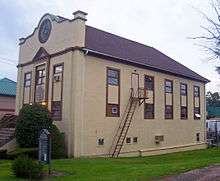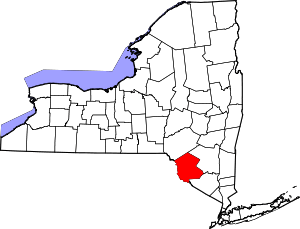South Fallsburg Hebrew Association Synagogue
The South Fallsburg Hebrew Association Synagogue is located on Lake Street in the hamlet of South Fallsburg, New York, United States. Built in 1902, it underwent a major expansion in 1919 that included being raised a story.
| South Fallsburg Hebrew Association Synagogue | |
|---|---|
 West profile and north elevation, 2008 | |
| Religion | |
| Affiliation | Orthodox Judaism |
| Leadership | Rabbi Yakov Barros* |
| Location | |
| Location | South Fallsburg, New York, US |
| Geographic coordinates | 41°42′25″N 74°37′49″W |
| Architecture | |
| Style | Early 20th-century revivals |
| Completed | 1902[1] |
| Specifications | |
| Direction of façade | north |
| Materials | concrete, stucco |
| U.S. National Register of Historic Places | |
| Added to NRHP | 2000 |
| NRHP Reference no. | 00001410 |
| Website | |
| South Fallsburg Hebrew Association SFHA | |
It is one of the oldest synagogues in Sullivan County, and has played a central role the region's Jewish community, with some notable Jews having been members of the congregation. It is officially Orthodox, but welcomes all Jews regardless of their level of observance. After a period of decline that mirrored that of the Catskill region's Jewish resorts that had supplied its membership, a new rabbi has begun to restore the synagogue's role in local Jewish life. In 2000 it was listed on the National Register of Historic Places.
Building
The synagogue is a one-story three-by-five-bay on a raised basement. The slight slope of the site exposes the basement walls on the rear and sides. It is sided in gold stucco topped with an asphalt-shingled hipped roof, partially obscured by the parapets of the north (front) facade.[1]
Concrete stairs with iron railings and brick newels lead up to the entrance, flanked by two windows, wooden surrounds and a cornice with a small pediment. At the outer edges, wooden pilasters with Doric capitals rise from basement to cornice. The entire facade is topped by a Spanish Baroque-inspired parapet, within which a stained glass window depicts one Star of David nested in another.[1]
The sides feature narrow, flat windows in each bay. On the east is a shed-roofed ground-level entrance and concrete block chimney; opposite is a metal fire escape. The rear has a projecting middle bay (the Torah ark on the inside) plus two similar windows.[1]
Inside, the synagogue uses all three of its floors. The main floor is devoted to the sanctuary, where the bimah is unusually placed in the rear, near the ark, rather than the center as is customary in Orthodox synagogues. The ark itself is separated from the bimah by sliding wooden doors and illuminated by stained glass depicting the Burning bush; two backlit panels show the Ten Commandments. The ceiling is the original pressed metal.[1]
A women's gallery and some classrooms are located on the third level. The basement is a large community room used for ceremonies and gatherings; it has a sukkah of knotty pine panelling with a retractable bamboo ceiling.[1]
History
As the 19th century yielded to the 20th, Jewish immigrants began coming to the southern Catskill Mountains to stay at, and later operate, summer resort communities. There were enough in South Fallsburg to build the synagogue, originally known as Ahavas Achim, in 1902. Its design owed much to the congregants' memory of synagogues in the Eastern European countries many had originally emigrated from. All Jews were welcome to join regardless of whether they were Orthodox or not.[1]
In 1910 the congregation changed its name to the South Fallsburg Hebrew Association (SFHA), reflecting its function as a center for local Jews regardless of religious sect. It bought and operated a local secular Yiddish school. Enough Jews had made South Fallsburg their permanent home after vacationing there that the synagogue held weekly meetings year-round. Members were prosperous enough to begin banking money for synagogue expansions, and in 1919 the building was elevated to build a Talmud Torah school in the new basement. A women's gallery was added and the building was elongated to accommodate the growing congregation. At this time a new ark was also built.[1]
Throughout the middle decades of the century, the synagogue served one of the region's most active and prosperous Jewish communities. In 1959, all the local firefighters were also members of SFHA. Its members included notable Jews like two-time Oscar-winning songwriter Sammy Fain and influential Israeli rabbi Nachman Bulman.[2] In the 1970s, the interior was remodeled, with Jewish folk art that had hung from the balustrade by the women's gallery removed to project an image of greater sophistication. The original stained glass window was replaced at this time as well.[1]
The resort industry began to decline after that, and South Fallsburg's Jewish community felt the effects, with many of its children choosing to settle elsewhere in adulthood. The synagogue saw attendance drop off, and it became a struggle to maintain the building and get enough men together for a minyan on the Sabbath. The congregation pondered whether to remain Orthodox, especially when many members were not personally so.[1] That was not done, but the synagogue describes itself "open to all Jews regardless of their level of observance".[3] In December 2004, Yakov Barros, a young rabbi was 'hired',[4] and he began reversing that decline and increasing attendance at the synagogue's Hebrew school.[1]
References
- LaFrank, Kathleen (August 2000). "National Register of Historic Places nomination, South Fallsburg Hebrew Association Synagogue". New York State Office of Parks, Recreation and Historic Preservation. Retrieved April 28, 2009.
- Mayberg, Nathan (August 1, 2007). "Fallsburg synagogue's forefathers honored". Times-Herald Record. Ottaway Community Newspapers. Retrieved April 28, 2009.
- "South Fallsburg Hebrew Association SFHA". South Fallsburg Hebrew Association. Archived from the original on July 14, 2010. Retrieved April 28, 2009.
- The rabbi of more than 3 decades 'dismissed' at that time, Isaac Gottlieb, claimed he did not resign and was not fired, and after returning to the synagogue several times and being legally barred from reentering by a New York State Supreme Court restraining order, filed suit in the Sullivan County Courts against the shul in March 2005, as well as the Beth Din Religious Courts in New York City. While his status as Rabbi was upheld by the rabbinical courts (which is unenforceable without the cooperation of all parties involved in a dispute), Gottlieb's civil lawsuit against the synagogue and its leadership remains in the county courts due to numerous delays. In April 2005, the synagogue file a counter lawsuit against Gottlieb for $260,000 in damages, and the two lawsuits are now enjoined.
External links
- Official website
- Synagogue listing on Walk2Shul.com
- Ramsey Al-Rikabi (May 2, 2005). "Rabbi, temple in legal battle". Times Herald-Record – via Jewish Whistleblower. Article on Gottlieb Lawsuit.


